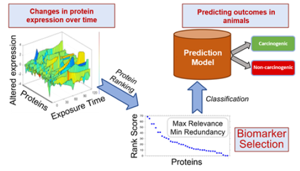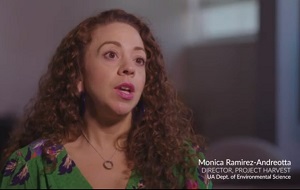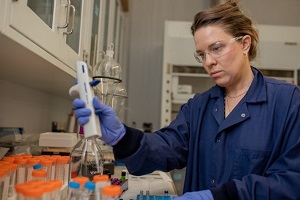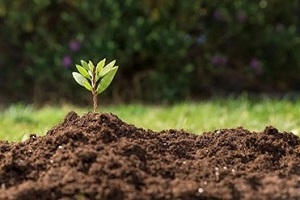Hot Off the Press
The Superfund Research Program (SRP) regularly highlights basic and applied research and activities from the program that span multiple disciplines.
Research Briefs
Leveraging Machine Learning to Predict Toxicity
SRP grantees developed a new computational approach to predict how hazardous substances may affect health based on key changes in cells. Led by April Z. Gu, Ph.D., of the Northeastern University Puerto Rico Testsite for Exploring Contamination Threats (PROTECT) SRP Center, researchers used machine learning and advanced algorithms to link biological changes from high throughput cell studies with health outcomes observed in animal studies.
New Technique Yields Promising Results for Uranium Removal in the Field
A new technology may remove uranium and other heavy metals from groundwater near abandoned mines. Small business GlycoSurf, LLC worked with partners at the University of Arizona SRP Center to determine the best environmental conditions for effectively removing uranium from contaminated water.
Biosensor Helps Characterize Contaminants and Health Risks Following Disasters
A sophisticated biosensor may provide information about contaminant distribution in the aftermath of natural disasters, according to a study made possible by a K.C. Donnelly Externship Award. Led by former Texas A&M University SRP Center trainee Krisa Camargo and Michael Unger, Ph.D., from the Virginia Institute of Marine Sciences, the team demonstrated this type of tool is useful for quickly characterizing and prioritizing environmental samples for further analysis.
Exposure to Airborne PCBs an Ongoing Challenge, Expert Says
Approaches for studying airborne exposure to polychlorinated biphenyls (PCBs) - and helping communities reduce such exposure - were discussed by University of Iowa SRP Center Director Keri Hornbuckle, Ph.D., during her February 4 Keystone Science Lecture.

Building Trust, Sharing Data: Grantee Promotes Participatory Research
During her February 14 NIEHS Keystone Science Lecture, Monica Ramirez-Andreotta, Ph.D., shared the numerous ways she works with communities to integrate their priorities into environmental health sciences research. The University of Arizona professor directs Gardenroots and Project Harvest, which are citizen science initiatives that engage community members about the health of their soil, water, and plants.
Educational Tool Highlights COVID-19 and Arsenic Research
A new online educational resource invites high school students to examine ways that humans are exposed to arsenic and how exposure might influence susceptibility to COVID-19 infection. The tool was developed by the SRP Center at the University of North Carolina at Chapel Hill.
Extramural Paper of the Month: Changes in Gut, Liver may Contribute to Alzheimer's Disease Susceptibility
SRP-funded researchers determined how changes in the gut and liver may contribute to cadmium-induced Alzheimer's disease (AD). They previously showed that male mice with a genetic risk factor for AD were most susceptible to the disease following cadmium exposure. Here, they shed light on how cadmium and genetic susceptibility alter the gut and liver in ways that may promote AD.
Extramural Paper of the Month: Leveraging Unused Samples to Predict Metal Exposures
SRP-funded researchers demonstrated a robust approach for predicting exposure to arsenic and manganese using a commonly stored but often unused biological sample. As an alternative to using whole blood, their method used only the clotted erythrocyte fraction to track metal exposures.
Complexities of PFAS Research Focus of Congressional Hearing
Complexities of studying per- and polyfluoroalkyl substances (PFAS) were shared by SRP grantees and other experts during a congressional hearing. Witnesses discussed how increased research and development can better inform regulation and strengthen methods for cleaning up PFAS in the environment.
Extramural Paper of the Month: Database reveals toxic metals in private well water in NC
Leveraging two decades of well water data in North Carolina, SRP-funded researchers reported residents are exposed to arsenic and lead above the U.S. Environmental Protection Agency standards. Their publicly available database offers a valuable tool for researchers and citizens in the state to identify areas of highest concern.

Effort to Remove PFAS from Water Earns Grad Student Wetterhahn Award
University of Kentucky SRP Center trainee Molly Frazar is the 24th recipient of the Karen Wetterhahn Memorial Award, which is bestowed annually by SRP. Frazar was recognized for her work to develop inexpensive and reusable sorbent materials to clean up drinking water contaminated with PFAS.
2021 Papers of the Year: Plant Leaves Work as Reliable Air Monitor in Citizen-Science Study
Working with citizen-scientists, SRP-funded researchers demonstrated that leaves can be used as a low-cost, reliable method to assess the level of metals in airborne dust. The method can help assess exposure from former mine sites that emit heavy metals that can be distributed by wind to nearby communities.
Extramural Paper of the Month: Microbiome Affects Early Childhood Behavior Differently in Girls and Boys
Bacteria in the gut of young children may relate to behavioral disorders, affecting girls and boys differently, according to an SRP-funded study. This is one of the first studies to examine associations between the microbiome, the collection of bacteria and other microorganisms in the body, and a broad range of behavioral outcomes that may vary by sex.
Extramural Paper of the Month: Biosensor Characterizes Contaminants and Potential Health Risks After Disasters
A sophisticated biosensor may provide information about polycyclic aromatic hydrocarbon distribution and potential toxicity in the aftermath of natural disasters, according to an SRP-funded study. By rapidly characterizing and prioritizing samples for study, the tool supports disaster research response where time and resources are limited.

SRP is hosting a Progress in Research webinar series to showcase new breakthroughs to advance sustainable solutions for hazardous substances in the environment. The three-part series will feature SRP individual research projects funded in 2020, who are incorporating new advances in materials science to optimize bioremediation of contaminants in soil, sediment, or water.
The first session , April 15, from 1-3 p.m. EST, will highlight sustainable technologies to clean up per- and polyfluoroalkyl substances from the environment. Speakers include investigators from University of California, Riverside, Princeton University, and State University of New York at Buffalo.
The second session , April 29, from 1-3 p.m. EST, will showcase novel tools to remove chlorinated compounds from the environment. This session will feature speakers from Florida State University, Oregon State University, University of Iowa, and University of Maryland, Baltimore County.
The third and final session , May 13, from 1-3 p.m. EST, will focus on plant and fungal-based bioremediation. Speakers include researchers from Texas A&M Agrilife Research, University of Massachusetts Amherst, and Yale University.
to Top



